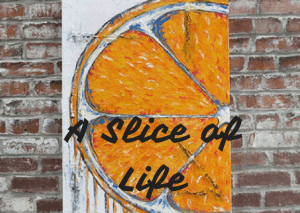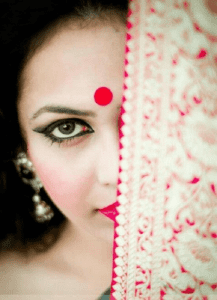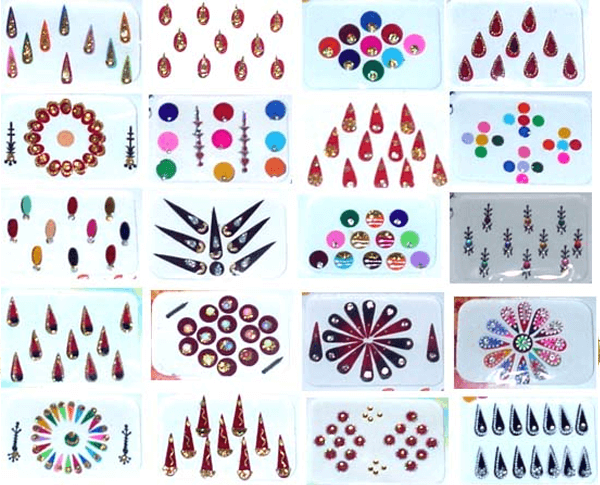Reading Time: 3 minutes
Ruchira unveils secret of wearing a bindi, an Indian tradition loaded with cultural nuances. An exclusive for Different Truths.
 Anyone having the remotest link with the Indian subcontinent is familiar with what is known as the bindi. Although a mere speck or a tiny spot, a bindi is replete with great significance and showcases deep rooted cultural heritage.
Anyone having the remotest link with the Indian subcontinent is familiar with what is known as the bindi. Although a mere speck or a tiny spot, a bindi is replete with great significance and showcases deep rooted cultural heritage.
How many of you are aware that the word ‘bindi’ is derived from the Sanskrit ‘Bindu’, which means a dot or a spot?
According to Hindu traditions, humans are akin to deities like Shiva, Durga, Kali, and more, possess a third inner eye. Interestingly the two physical eyes are to be used for seeing the external world, while the third is envisaged to focus inwardly on the Almighty Creator.
According to Hindu traditions, humans (read mortals) are akin to deities like Shiva, Durga, Kali, and more, possess a third inner eye. Interestingly the two physical eyes are to be used for seeing the external world, while the third is envisaged to focus inwardly on the Almighty Creator. In this context, the dot symbolises compassion, besides exhorting people to be perpetually aware of a divine presence.
There is also a mystic angle to the bindi. The tiny area of the forehead that separates the eyebrows is known as the sixth or agya chakra, (Chakra = node, Agya = command). There are several chakras (vital nodes) located across the human body. However, the sixth one is most powerful among them all, since it is the store house of wisdom. As per Tantric beliefs, during meditation latent energy unleashed from the base of the spine rises upwards toward the head, and the agya chakra swings into action as an outlet for this newly kindled energy.
As red is considered highly auspicious, it is abundantly used while performing all major Hindu rites and rituals. Accordingly, men and women mark their foreheads with a red dot on all important social occasions
As red is considered highly auspicious, it is abundantly used while performing all major Hindu rites and rituals. Accordingly, men and women mark their foreheads with a red dot on all important social occasions and festivals. The red spot between the eyebrows apparently maintains, controls, and distributes the energy across the entire human form. It boosts concentration, which, in turn, enables the agya chakra to issue commands for diverse bodily functions.
During the traditional nuptial rite of sindoordan,the groom vertically smears his bride’s forehead and the parting of the hair with vermilion (sindoor). Since there is a colour overdose, the newlywed bride splits up the sacred red mark into a bindi plus a modest touch in the parting of the hair. By and large it is a daily regimen for married women to sport red bindis to highlight their marital status. However red has been conveniently replaced by multiple shades, in order to match women’s attires and bangles (another vital sign of matrimony). So now red is mainly confined to auspicious occasions.
In earlier times, the vermilion bindi was a signature statement for married, decent women. However, owing to the dot’s cosmetic and aesthetic appeal, the not-so-decent women also came out with their own style of bindi.
In earlier times, the vermilion bindi was a signature statement for married, decent women. However, owing to the dot’s cosmetic and aesthetic appeal, the not-so- decent women also came out with their own style of bindi. This explains the evolution of glossy, gaudy, glittering bindi, which remained mostly confined to nautch girls and tawaifs (dancing girls, courtesans).
decent women also came out with their own style of bindi. This explains the evolution of glossy, gaudy, glittering bindi, which remained mostly confined to nautch girls and tawaifs (dancing girls, courtesans).
On the flip side, Indian (read Hindu) society has Draconian laws for widows who must not sport a bindi more so a red one. I for one fail to understand what a minuscule speck of colour has got to do with a woman’s loss of partner. Why in the name of heavens must she be condemned as inauspicious, ill-omen for her family?
However I am glad to note that the glass wall is crumbling and many a widow is freely using bindi as an accessory.
Originally round, the bindi now assumes myriad shapes e.g., peacock, paisley, exclamation mark, compound leaf, tear drop and what have you!
Over the decades the bindi has undergone vast changes, and incorporated several new features for greatest good of the greatest number, so to say. Originally round, the bindi now assumes myriad shapes e.g., peacock, paisley, exclamation mark, compound leaf, tear drop and what have you!
Importantly, powder and liquid bindis have been replaced by velvet textured stick-on, which may be used over and over again so long as the gummy side remains intact. As a matter of fact, bindi manufacturing is a flourishing industry now!
Personally, I can vouchsafe that women find it rather convenient. Earlier, when I was younger I loved sporting sindoor bindis. But the heat and sweat would play havoc and many a times I had red colour streaming down my nose. Hence I switched over, for good.
Photo from the Internet
















